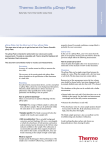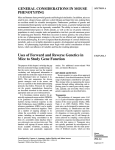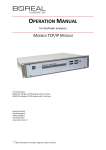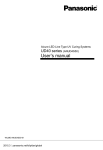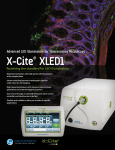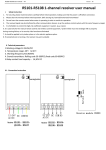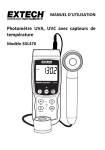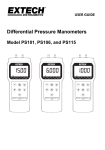Download manual ProPS
Transcript
manual ProPS submersible hyperspectral UV-transmissiometer for chemical-free substance analysis release: 2003-09-03 TriOS GmbH Werftweg 15 26135 Oldenburg Germany fon: +49 (0) 441 48598 0 fax: +49 (0) 441 48598 20 [email protected] www.trios.de release: 2003-09-03 ProPS Content Content ..................................................................................................2 Principle of operation............................................................................3 Operation ..........................................................................................6 Preparation.........................................................................................6 Connection........................................................................................................ 6 Powersupply ..................................................................................................... 6 Adjustment of Pathlength .................................................................7 Clear Water Version ......................................................................................... 8 Waste Water Version........................................................................................ 9 Calibration .............................................................................................9 Maintenance ........................................................................................10 Appendix..............................................................................................10 Dimensions ......................................................................................10 WasteWater Version:...................................................................................... 10 ClearWater Version: ....................................................................................... 11 Technical Specifications .................................................................12 Connection.......................................................................................13 Trouble shooting .................................................................................14 Software ...............................................................................................14 Safety & Hazards .................................................................................14 Warranty...............................................................................................15 Contact information ............................................................................16 TriOS Optical Sensors 2/2 release: 2003-09-03 ProPS Principle of operation The ProPS is a hyperspectral transmissiometer for the ultraviolet spectral region. A miniaturized Deuterium lamp is used as a light source. A lens with a short focal length is used to get a parallel beam. The beam is passing a beam-splitter to split the beam into the measurement and the reference beam (about 2-4% of the beam intensity is used for reference, detected by a UV-photodiode). The optical output of the miniaturized lamp is stable within <0.1% after a few seconds. Therefore the reference signal is only used to monitor aging effects of the lamp. The measurement beam is passing the chosen optical pathlength in the water sample and is focused by a lens to the optical fibre bundle of the detector spectrometer (TriOS miniSpec UV). The combination of the lens and the small area (0.5mm diameter) of the fibre are building the small acceptance angle of the detector system, required for accurate beamattenuation measurements. The full measured absorption spectrum in the UV (200-385nm) is transmitted by the probe to the corresponding software. Fig. 1 principle of operation These UV absorption spectra are used to distinguish various chemical species and their concentrations in situ out of a natural sample. Prominent UV absorber in the nature are bromide, nitrate, nitrite and CDOM. They all have an individual spectral absorption 'fingerprint', which allows an intelligent software algorithm (based on principle component analysis) to distinguish between them and calculate their individual concentrations in a TriOS Optical Sensors 3/3 release: 2003-09-03 ProPS natural mixed sample. Some absorption spectra of the important species of UV-absorber are given in Fig. 2 Fig. 2 Absorption spectra of the main UV absorber in seawater Actually, there are two versions of the ProPS available to fit the requirements of various water types: ProPS (ClearWater) with adjustable optical pathlengths between 10..60mm (10, 20, 40 or 60mm using adapter tubes) (Fig. 3) ProPS (WasteWater) with adjustable optical pathlengths between 1..10mm (free adjustable using a spanner) (Fig.4) TriOS Optical Sensors 4/4 release: 2003-09-03 Fig. 3 ProPS (ClearWater) with a adapter tube for 10mm optical pathlenght in water TriOS Optical Sensors ProPS Fig. 4 ProPS (WasteWater) with a maximum optical pathlenght of 10mm in water 5/5 release: 2003-09-03 ProPS Operation Preparation Connection Take the orange PUR SUB-M8 cable (one end black underwater female SUBCONN and the other end male M8 industrial connector). Fit the female SUBCONN plug to the ProPS and the male M8 industrial plug to the Powersupply (see Fig. 6). Powersupply Fig. 5 Powersupply PS101 The power supply PS101 transforms the 115 and 230 VAC line voltage respectively to 12 VDC required for sensor operation. At the front of the PS101 there are 3 LED (see Fig. 5): The green power-LED at the front of the PS101 is lighted if line power is connected and the unit is switched ON. Both yellow LED are on half power when a sensor is connected. The yellow command LED flashes if the PS101 is sending a command to the sensor and the upper yellow data LED flashes if is gets data from the sensor. TriOS Optical Sensors 6/6 ProPS release: 2003-09-03 To 115/230VAC line Power On/OFF To the PC To the ProPS Fig. 6 Back side of the PS101 The line-switch is on the backside of the PS101 (see Fig. 6). The socket for the data connection to the personal computer is a serial 9 pin SUB-D female (RS232). The connection to the instrument takes place by a 4 pin M8 industrial connector female. The 115 and 230 VAC power respectively is established by a 3 pin male line socket. Adjustment of Pathlength The pathlength of the ProPS has to be adjusted to the medium to guarantee optimised conditions for the measurement. Therefore a sample measurement with the longest pathlength is needed. If the measured intensity is lower than 0.5 the pathlength has to be shortened. TriOS Optical Sensors 7/7 release: 2003-09-03 ProPS Clear Water Version Fig. 7 Adjustment of pathlength ClearWater Version To adjust the pathlength of the Clear Water ProPS one of the window adapter tubes must be mounted: 1. The window adapter tube, the window frames and the window must be clean and dry. If necessary clean it with optical tissue and ethyl alcohol. 2. Then put the window tube holder in the keyway and move it to the upper window frame. (see Fig. 7) 3. Put the seal ring on the window frame. 4. Put the window adapter tube on the window frame. 5. Move the tube holder to the tube. 6. Fix it with 2 countersunk-head screws. TriOS Optical Sensors 8/8 release: 2003-09-03 ProPS Waste Water Version Fig. 8 Adjustment of pathlength WasteWater Version To adjust the pathlength of the Waste Water ProPS the Window screw must be screwed out: 1. take a 13mm spanner 2. turn the window screw around until the required pathlength is achieved (1mm per 1 full rotation) 3. check the pathlength with the white gauge (delivered with the instrument) Calibration As described above, the measurement principle for identifying single substances in the mixture sample is based on principle component analysis using the individual absorption characteristics of the single substances. Therefore, instrument calibration requires the measurement of the single absorbing substances, which should be distinguished in the real sample later on. These optical fingerprints are building the basis for the so called water matrix, allowing the software to calculate the single concentrations. A wide range of pure substances, like nitrate or nitrite, can only be measured dissolved in a liquid, e.g. water or ethanol. Within the software, the absorption of the solvent is subtracted from the spectra. This gives the pure fingerprint of the remaining substance in the known concentration. Additionally, mathematical functions or artificial spectra can be used. TriOS Optical Sensors 9/9 release: 2003-09-03 ProPS For more details and the single steps of calibration refer to the corresponding ProPS chapter in the actual MSDA_XE software manual. Maintenance Following each deployment the ProPS should be washed off with freshwater. Inspect the windows and clean them from sand and sediments with a soft brush. If it is necessary clean the windows with optical tissue and ethyl alcohol. Finally the windows could be wiped with acetone. Check the cables and plugs. ► Do not open the ProPS! Appendix Dimensions WasteWater Version: Fig. 9 Dimensions of WasteWater ProPS TriOS Optical Sensors 10/10 release: 2003-09-03 ProPS ClearWater Version: Fig. 10 Dimensions of ClearWater ProPS TriOS Optical Sensors 11/11 ProPS release: 2003-09-03 Technical Specifications Technical specifications Detector wavelength range 200..385 nm detector types MMS UV module (Zeiss, Germany) spectral sampling 0.8 nm / pixel spectral accuracy 0.2 nm Usable channels 255 light source Type Deuterium lamp life-time 1,000h continuous operation (50% intensity at 240nm) Electrical telemetry data interface RS-232 data rate 1,200 .. 38,400 baud (9,600 baud default) Power requirements 9..36 VDC Connector SUBCONN-Micro 5 pins, male connector Physical optical pathlength 10 .. 60 mm (ProPS-ClearWater) 1..10 mm (ProPS-WasteWater) Size ∅68 mm x 485mm (without connector) weight in air 4.9 kg depth rating 3,000 m (stainless steel) operating temperature 0 to +50 °C Tab. 1 Technical specifications of ProPS TriOS Optical Sensors 12/12 ProPS release: 2003-09-03 Technical specifications PC interface PS101 Type RS-232 (9 pin SUB-D) sensor interface Channels 1 Type RS-232 (M8 industrial connector) Electrical power requirements Version 1: 115 VAC or 12V DC Version 2: 230 VAC or 12V DC Physical Size 120 x 60 x 215 mm3 operation temperature 0 - 40 °C Tab. 2 Technical specifications of the PS101 Connection SUBCONN-Micro 5 pin connector RS 232 interface 1. Ground 2. RS232 RX (commands) 3. RS232 TX (data) 4. Power 5. not connected TriOS Optical Sensors 13/13 ProPS release: 2003-09-03 Trouble shooting communication problems between sensor and computer software problems • • • • • • check the LED for data communication with the power supply (see Powersupply, page 6) check cables and plugs switch OFF the PS101, wait 30 seconds and switch ON check serial computer interface restart msda-software check software settings (see software manual) • see software manual Software Please refer to the MSDA_XE software user manual. Safety & Hazards The operator should always remain aware of the cable. Any cable or line released from a ship or platform can be dangerous. Keep a safe distance from the cable coil when the instruments are being used. Do not leave the instruments in direct sunlight when not in use, to beware the instrument of over-heating (direct sunlight can easily increase the internal temperature of the instrument beyond the maximum ratings). Do not use the cable directly for lowering the instrument. Use always are separate rope, fixed on the instrument frame, in parallel to lower the setup. Cables supplied by TriOS are not designed to withstand strong mechanical strains (to keep them thin and easy to handle). Handle electrical terminations carefully, as they are not designed to withstand strain. Disconnect the cables from the instruments by pulling on the connector heads and not the cables. Do not twist the connector while pulling, as this will damage the connector pins. Be sure to rinse seawater from the instrument with fresh water prior to storage. Corrosion resulting form failure to do so is not covered under warranty. TriOS Optical Sensors 14/14 release: 2003-09-03 ProPS Warranty Warranty time is 2 years following the date of invoice. Excluded from warranty are all parts of the instrument which are normal consumables, e.g. light sources. Warranty is bounded to a proper use of the instrument and accessories, e.g. 1. The instrument and attachments must be installed, powered and operated in compliance with the directions in this manual. 2. Damage resulting from contact with incompatible materials, fluids or gases (e.g. corrosive, acid or solvent materials, fluids or gases) is not covered. 3. Damage incurred by shipment is not covered. 4. Damage by improper treatment by the customer is not covered. 5. Damage by modification of the instrument or mounting improper parts by the customer is not covered. 6. An opening of the instrument by the customer will lead in a loose of warranty ! TriOS Optical Sensors 15/15 release: 2003-09-03 ProPS Contact information We are always working to improve our products. Please check our website for updates. You have found an error in this instrument/program, or you would like to see some additional features enabled in a future version? Feel free to contact us at: [email protected] Our website: www.trios.de TriOS Mess- und Datentechnik GmbH Werftweg 15 D- 26135 Oldenburg Germany fon +49 (0) 441 4 85 98 -0 fax +49 (0) 441 4 85 98 -20 TriOS Optical Sensors 16/16
















